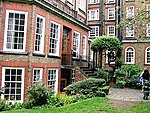Sylvia Young Theatre School
1981 establishments in EnglandDance schools in the United KingdomDrama schools in LondonEducational institutions established in 1981Independent co-educational schools in London ... and 5 more
Independent schools in the City of WestminsterMember schools of the Independent Schools Association (UK)Schools of the performing arts in the United KingdomSylvia Young Theatre SchoolUse British English from August 2012

Sylvia Young Theatre School is an independent school in Marble Arch, London, England. It is a specialist performing arts school named after its founder and principal, Sylvia Young OBE.
Excerpt from the Wikipedia article Sylvia Young Theatre School (License: CC BY-SA 3.0, Authors, Images).Sylvia Young Theatre School
Nutford Place, London Marylebone
Geographical coordinates (GPS) Address Website External links Nearby Places Show on map
Geographical coordinates (GPS)
| Latitude | Longitude |
|---|---|
| N 51.516944444444 ° | E -0.1625 ° |
Address
Sylvia Young Theatre School
Nutford Place 1
W1H 5YZ London, Marylebone
England, United Kingdom
Open on Google Maps






